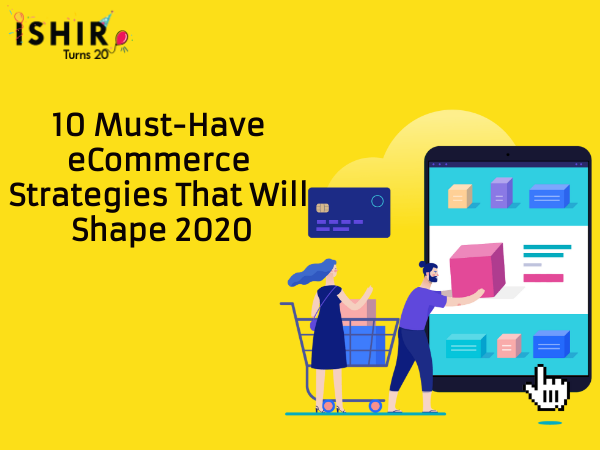Who would have thought that one book could change the landscape of how we do business today? The title of the book doesn’t really matter. All that matters is that it was the first book to be sold on Amazon in 1995. Now, 25 years later, the eCommerce industry has been responsible for more than $2 trillion in sales all over the world.
E-commerce is not the way of the future anymore, it is now, and it is here to stay. So, to keep up with the times, here are ten strategies for you to bolster your e-commerce platform.

Online sales growth is unstoppable
One of the most popular activities online is online shopping, and this is the reason why E-commerce sales have been growing steadily from $1.3 trillion in 2014 to a projected $4.5 trillion in 2021. That is an astronomical number. Few industries can show a threefold growth in just seven years.
There are a number of reasons for the increase in online shopping. Probably one of the most important reasons is the comfort and convenience.
We have also come a long way in improving website’s user experience and increasing security; this has contributed to a rise in trust in some hesitant users. With these improvements made, it is no surprise that this industry is becoming unstoppable.
Fulfillment options are expanding
When it comes to clients abandoning the sale, there are a few common reasons and most of them have to do with fulfillment, specifically:
- Cost of shipping
- Shipping times that take too long
- Not enough delivery options
Naturally, you can’t please everyone and stay profitable. If your e-commerce company has a brick-and-mortar location, then a simple solution exists: offer your customer a buy online, pickup in-store (BOPS) option.
It’s weird that with online shopping offering customers convenience and comfort, a lot of customers will still prefer to pick it up by themselves. If you do not have a physical location, it might be a good idea to team up with a partner that has one.
Going beyond the online store with omnichannel
Customers have a growing need to communicate directly with a brand. So, while retailers have been focusing on getting their stores online in the last decade, the new focus is customer engagement.
It is extremely important to create a cross channel or omnichannel brand. This gives the brand a chance to connect with customers on a deeper level. This allows a client to feel like the brand cares about them as a person, and not just as another click or number – it’s deep and personal.
So, in addition to your website and online store, you might want to get an interactive social media account – or two or three – and be active on those, rather than just a static page.
Mobile shopping & mobile payments
Since the invention of the smartphone, mobile commerce has been on a steady rise to the top. Approximately 4 out of 5 Americans shop online and more than half of them do it on their smartphones. Europeans surpass this number with 55% of them using mobile devices.

This trend is not likely to slow down anytime soon, seeing as we are spending more and more time on our phones, with the average person already being on their phone for four or more hours per day.
Sarah McGraw, the digital marketing head for coursework writing service department at EduBirdie review, says that E-commerce businesses do their best to make their mobile apps and mobile websites easy to use. Thus it is extremely important to have the best mobile app UI design tools to stay ahead of this trend.
Environmental topics influence buyers
People are growing more environmentally conscious, and brands need to keep up. More than 50% of online customers admit that environmental concerns will impact if they buy from a store or not. This kind of green consumerism is on the rise and for all the right reasons.
The consumer is keeping brands accountable, and if a brand falls behind on consumer standards, they are left behind. A challenge that the brands have to see through is to get their products from a fair-trade organization to help create a cleaner e-commerce environment.
The largest of the online consumers, Millennials, are setting the standards for better, greener consumer habits.
Tailor your store setup based on product price point
If the products in your store are everyday items that are inexpensive, widely available, and regularly bought, making the shopping experience fast and easy is the best sales tactic. You can add a “buy now” button that circumvents steps from the button click and the checkout button to make it as fast as possible.
For products that require deeper thought, the customer needs to get all the information possible of the product to assure them of the value and benefit of the product.
This can be done by adding detailed product description pages, including videos and 3D models, all to ensure the consumer feels informed when they are buying the product. Also remember to add a variety of payment options.
Adopting the fast-fashion mindset
The fast-fashion e-commerce industry has caused a big disruption in the industry in the last couple of years, growing up to 4.5% in 2019 only. There are four key reasons that the fast-fashion could attain growth like that
- Speed
- Endorsements from influencers
- Social sales
- Sustainability
It doesn’t matter which industry a brand operates in; everyone can take a lesson from the fast-fashion industry. When talking about speed, think about how you can optimize your production and fulfillment. Try going for a wasteless process, as this will increase your speed, and increase the company’s green look.
Voice commerce
Voice assistants are really growing in popularity. By 2023 it is expected that there will be approximately 8 billion voice-activated devices. Voice shopping is predicted to grow to $40 billion as early as next year.
But it seems that e-commerce brands still don’t understand the potential in these devices. At present, only about 11% of smart speaker owners in the U.S. are using them to do online shopping.
Yet making an order by voice is natural, intuitive and hands-free, and it does not require any more input. There is still development to be made in voice technology, but if the e-commerce industry starts using it, it could drive this development.
Chatbots: Communication with customers made smarter
The global chatbot market is huge and is expected to bring in more than $1billion by 2025, and e-commerce is the largest part of this market.
When it comes to customer service, chatbots will carry on to be one of the biggest e-commerce trends in 2020. The global chatbot market grew by 24.3% in 2019 alone. 45% of online consumers choose chatbots over actual humans when it comes to customer service inquiries.

AI and machine learning
AI allows technology to understand human habits and tendencies. This is where it is of value in the e-commerce market. The potential of Artificial Intelligence(AI) and machine learning grows daily. As we search and browse, it is learning. It is learning our habits, what we like, what we don’t like and so much more. But AI is moving away from just smart recommendations and is being implemented in all stages of a customer’s shopping journey.
Artificial Intelligence(AI) remains the hottest trend in e-commerce because they give marketers a powerful weapon to target a customer on a personal level.
Conclusion
Now at the onset of 2020, we need to realize that e-commerce is here to stay and that it is a very personal, interactive, and responsible way to do business. Almost like the corner store where the old owner knew all his regular customers personally. That is what e-commerce is, but on a much larger scale.
Need some help getting started with the eCommerce business? Talk to our eCommerce experts today.
What trends do you think will change the eCommerce game in 2020? Share your thoughts in the comments below.
Author Bio:
Tiffany Harper is an experienced writer from New York. From time to time she works as a content writer with Dissertation-today.com, their professional essay writers, research paper writing services, dissertation writing services, assignment writing service, mostly in motivation and self-growth areas. And sometimes she writes as blogger for ukbestessayss and their essay writing service. Do not hesitate to contact her on Twitter.




This is a question I often hear from companies: “We have a QA department, but we struggle getting them involved early enough in the project.” My answer is always the same: To fix this, you need to put testing at the heart of software development and include the entire agile project team.
Appreciate your sharing these tips that are indeed very helpful and useful. Keep it up!
Glad to see this post, I like the content of this post.